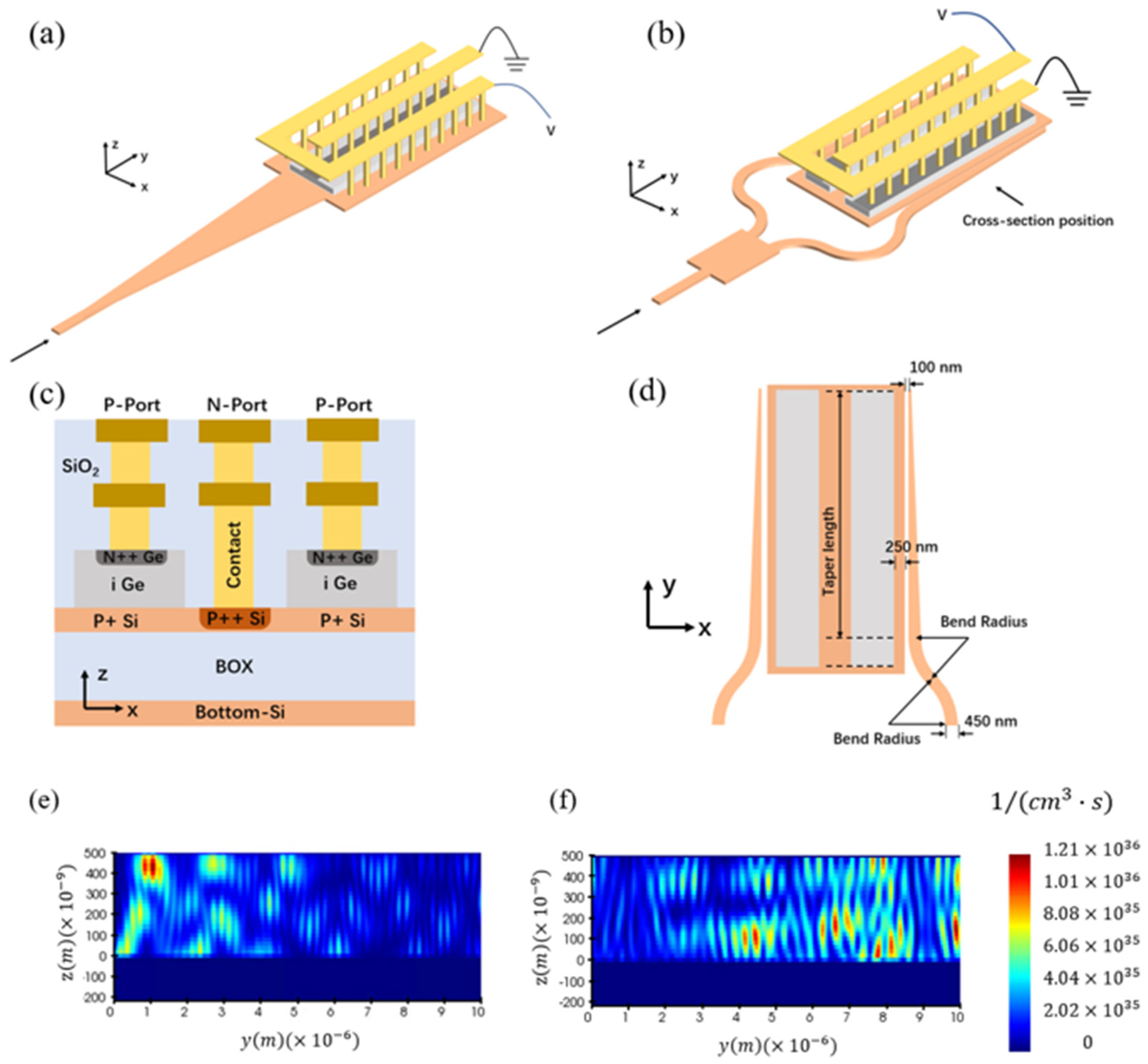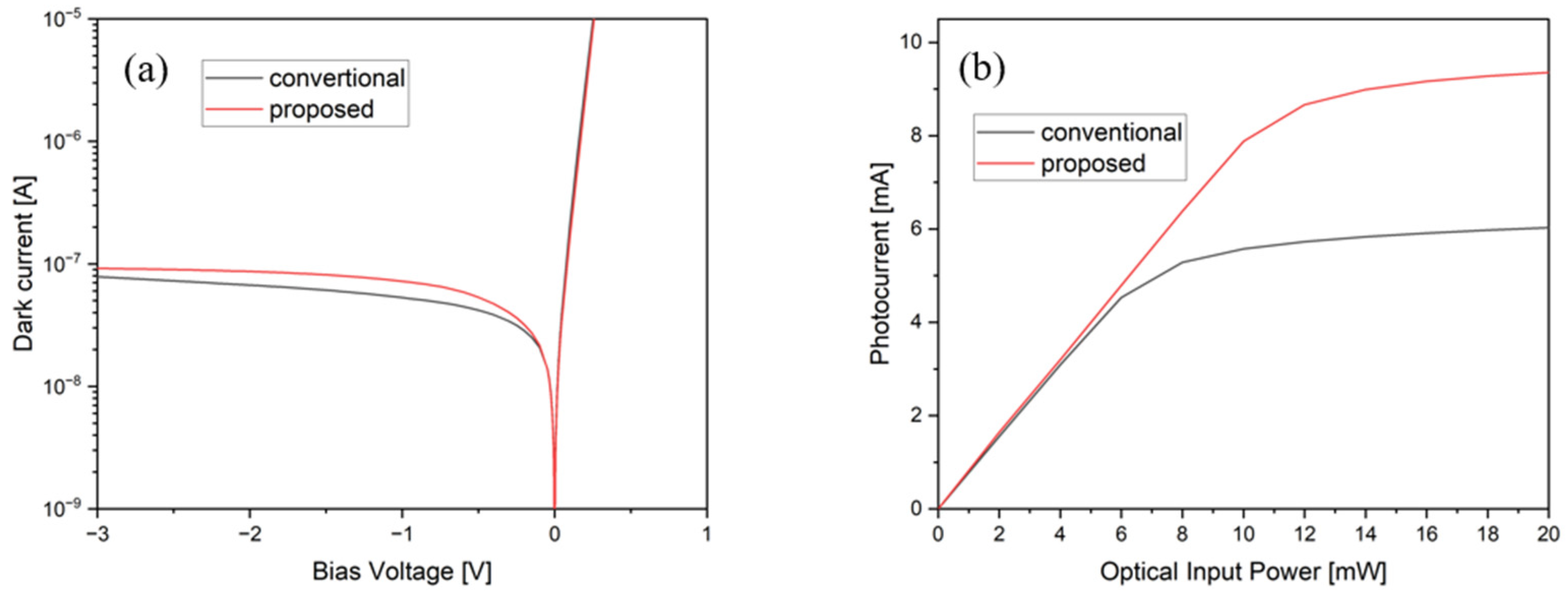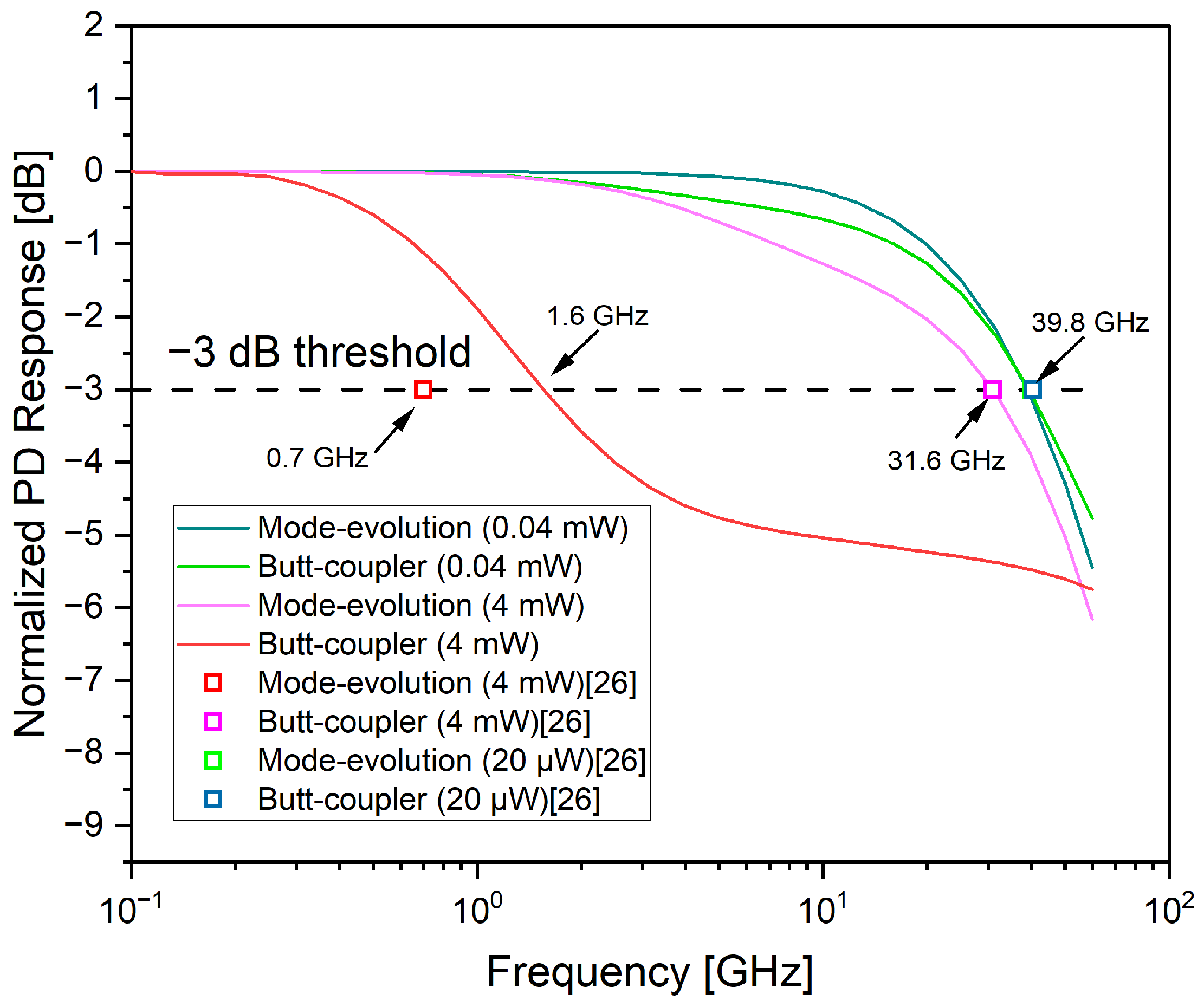High-Speed and High-Power Ge-on-Si Photodetector with Bilateral Mode-Evolution-Based Coupler
Abstract
:1. Introduction
2. Device Structure and Working Principle
3. Modeling Results and Discussion
3.1. DC and AC Characteristics
3.2. Equivalent Circuit Model
4. Conclusions
Author Contributions
Funding
Institutional Review Board Statement
Informed Consent Statement
Data Availability Statement
Acknowledgments
Conflicts of Interest
References
- Marpaung, D.; Yao, J.; Capmany, J. Integrated microwave photonics. Nat. Photonics 2019, 13, 80–90. [Google Scholar] [CrossRef] [Green Version]
- Seeds, A.J.; Williams, K.J. Microwave Photonics. J. Light. Technol. 2007, 24, 4628–4641. [Google Scholar] [CrossRef]
- Marpaung, D.; Roeloffzen, C.; Heideman, R.; Leinse, A.; Sales, S.; Capmany, J. Integrated microwave photonics. Laser Photonics Rev. 2013, 7, 506–538. [Google Scholar] [CrossRef] [Green Version]
- Zhang, Y.; Yang, S.; Yang, Y.; Gould, M.; Ophir, N.; Lim, A.E.-J.; Lo, G.-Q.; Magill, P.; Bergman, K.; Baehr-Jones, T. A high-responsivity photodetector absent metal-germanium direct contact. Opt. Express 2014, 22, 11367–11375. [Google Scholar] [CrossRef] [PubMed]
- Going, R.; Seok, T.J.; Loo, J.; Hsu, K.; Wu, M.C. Germanium wrap-around photodetectors on Silicon photonics. Opt. Express 2015, 23, 11975–11984. [Google Scholar] [CrossRef] [Green Version]
- Benedikovic, D.; Virot, L.; Aubin, G.; Amar, F.; Szelag, B.; Karakus, B.; Hartmann, J.-M.; Alonso-Ramos, C.; Roux, X.L.; Crozat, P.; et al. 25 Gbps low-voltage hetero-structured silicon-germanium waveguide pin photodetectors for monolithic on-chip nanophotonic architectures. Photonics Res. 2019, 7, 437–444. [Google Scholar] [CrossRef]
- Zeng, X.; Huang, Z.; Wang, B.; Liang, D.; Fiorentino, M.; Beausoleil, R.G. Silicon–germanium avalanche photodiodes with direct control of electric field in charge multiplication region. Optica 2019, 6, 772–777. [Google Scholar] [CrossRef]
- Chen, G.; Yu, Y.; Xiao, X.; Zhang, X. High speed and high power polarization insensitive germanium photodetector with lumped structure. Opt. Express 2016, 24, 10030–10039. [Google Scholar] [CrossRef] [Green Version]
- Zuo, Y.; Yu, Y.; Zhang, Y.; Zhou, D.; Zhang, X. Integrated high-power germanium photodetectors assisted by light field manipulation. Opt. Lett. 2019, 44, 3338–3341. [Google Scholar] [CrossRef]
- Lin, L.; Wu, M.; Itoh, T.; Vang, T.; Muller, R.; Sivco, D.; Cho, A. High-power high-speed photodetectors-design, analysis, and experimental demonstration. IEEE Trans. Microw. Theory Tech. 1997, 45, 1320–1331. [Google Scholar] [CrossRef]
- Williams, K.J.; Esman, R.D. Design considerations for high-current photodetectors. J. Light. Technol. 1999, 17, 1443. [Google Scholar] [CrossRef] [Green Version]
- Giboney, K.S.; Rodwell, M.J.W.; Bowers, J.E. Traveling-wave photodetector design and measurements. IEEE J. Sel. Top. Quantum Electron. 1996, 2, 622–629. [Google Scholar] [CrossRef]
- Li, Z.; Pan, H.; Chen, H.; Beling, A.; Campbell, J.C. High-Saturation-Current Modified Uni-Traveling-Carrier Photodiode With Cliff Layer. IEEE J. Quantum Electron. 2010, 46, 626–632. [Google Scholar] [CrossRef]
- Siew, S.Y.; Li, B.; Gao, F.; Zheng, H.Y.; Zhang, W.; Guo, P.; Xie, S.W.; Song, A.; Dong, B.; Luo, L.W.; et al. Review of Silicon Photonics Technology and Platform Development. J. Light. Technol. 2021, 39, 4374–4389. [Google Scholar] [CrossRef]
- Hu, T.; Dong, B.; Luo, X.; Liow, T.-Y.; Song, J.; Lee, C.; Lo, G.-Q. Silicon photonic platforms for mid-infrared applications [Invited]. Photonics Res. 2017, 5, 417–430. [Google Scholar] [CrossRef] [Green Version]
- Li, M.; Chen, X.; Su, Y.; Wang, X.; Chen, M.; Dai, D.; Liu, J.; Zhu, N.H. Photonic Integration Circuits in China. IEEE J. Quantum Electron. 2016, 52, 1–17. [Google Scholar] [CrossRef]
- Reboud, V.; Gassenq, A.; Hartmann, J.M.; Widiez, J.; Virot, L.; Aubin, J.; Guilloy, K.; Tardif, S.; Fédéli, J.M.; Pauc, N.; et al. Germanium based photonic components toward a full silicon/germanium photonic platform. Prog. Cryst. Growth Charact. Mater. 2017, 63, 1–24. [Google Scholar] [CrossRef]
- Michel, J.; Liu, J.F.; Kimerling, L.C. High-performance Ge-on-Si photodetectors. Nat. Photonics 2010, 4, 527–534. [Google Scholar] [CrossRef]
- Kim, M.; Olubuyide, O.; Yoon, J.; Hoyt, J. Selective Epitaxial Growth of Ge-on-Si for Photodiode Applications. ECS Trans. 2008, 16, 837. [Google Scholar] [CrossRef]
- Takenaka, M.; Morii, K.; Sugiyama, M.; Nakano, Y.; Takagi, S. Dark current reduction of Ge photodetector by GeO 2 surface passivation and gas-phase doping. Opt. Express 2012, 20, 8718–8725. [Google Scholar] [CrossRef]
- Chen, H.; Verheyen, P.; Heyn, P.D.; Lepage, G.; Campenhout, J.V. −1 V bias 67 GHz bandwidth Si-contacted germanium waveguide p-i-n photodetector for optical links at 56 Gbps and beyond. Opt. Express 2016, 24, 4622. [Google Scholar] [CrossRef] [Green Version]
- Zhou, H.; Liow, T.; Tu, X.; Lim, E.; Li, C.; Jia, L.; Huang, Y.; Luo, L.; Luo, X.; Song, J.; et al. Germanium-on-silicon photo-detectors based on tiny micro-disk resonators. In Proceedings of the 2016 Optical Fiber Communications Conference and Exhibition (OFC), Anaheim, CA, USA, 20–24 March 2016. [Google Scholar]
- Piels, M.; Bowers, J.E. 40 GHz Si/Ge Uni-Traveling Carrier Waveguide Photodiode. J. Light. Technol. 2014, 32, 3502–3508. [Google Scholar] [CrossRef]
- Chang, C.M.; Sinsky, J.H.; Dong, P.; Valicourt, G.D.; Chen, Y.K. High-power dual-fed traveling wave photodetector circuits in silicon photonics. Opt. Express 2015, 23, 22857–22866. [Google Scholar] [CrossRef]
- Cui, J.; Li, T.; Yang, F.; Cui, W.; Chen, H. The dual-injection Ge-on-Si photodetectors with high saturation power by optimizing light field distribution. Opt. Commun. 2021, 480, 126467. [Google Scholar] [CrossRef]
- Byrd, M.J.; Timurdogan, E.; Su, Z.; Poulton, C.V.; Fahrenkopf, N.M.; Leake, G.; Coolbaugh, D.D.; Watts, M.R. Mode-evolution-based coupler for high saturation power Ge-on-Si photodetectors. Opt. Lett. 2017, 42, 851–854. [Google Scholar] [CrossRef]
- Watts, M.; Haus, H. Integrated mode-evolution-based polarization rotators. Opt. Lett. 2005, 30, 138–140. [Google Scholar] [CrossRef]
- Snyder, A.W.; Love, J.D. Optical Waveguide Theory; Springer: Berlin/Heidelberg, Germany, 1983. [Google Scholar]
- Wang, G.; Tokumitsu, T.; Hanawa, I.; Sato, K.; Kobayashi, M. Analysis of high speed p-i-n photodiode S-parameters by a novel small-signal equivalent circuit model. IEEE Microw. Wirel. Compon. Lett. 2002, 12, 378–380. [Google Scholar] [CrossRef]
- Choi, W.; Shin, M.; Lee, J.; Zimmermann, L. Equivalent Circuit Models for Silicon Photonics Devices. In Proceedings of the 2016 Asia Communications and Photonics Conference (ACP), Wuhan, China, 2–5 November 2016. [Google Scholar]
- Lee, J.-M.; Cho, S.-H.; Choi, W.-Y. An Equivalent Circuit Model for a Ge Waveguide Photodetector on Si. IEEE Photonics Technol. Lett. 2016, 28, 2435–2438. [Google Scholar] [CrossRef]
- Lee, M.; Kang, H.; Choi, W. Equivalent Circuit Model for Si Avalanche Photodetectors Fabricated in Standard CMOS Process. IEEE Electron Device Lett. 2008, 29, 1115–1117. [Google Scholar] [CrossRef]
- Li, J.; Xiong, B.; Sun, C.; Miao, D.; Luo, Y. Analysis of frequency response of high power MUTC photodiodes based on photocurrent-dependent equivalent circuit model. Opt. Express 2015, 23, 21615. [Google Scholar] [CrossRef]
- Dai, D.; Chen, H.-W.; Bowers, J.E.; Kang, Y.; Morse, M.; Paniccia, M.J. Equivalent circuit model of a waveguide-type Ge/Si avalanche photodetector. Phys. Status Solidi 2010, 7, 2532–2535. [Google Scholar] [CrossRef]
- Zhan, X.; Liu, Q.; Wang, Y.; Tian, H.; Hu, A.; He, X.; Guo, X. Coupled Equivalent Circuit for High-Speed Photodiodes. IEEE Electron Device Lett. 2019, 40, 1654–1657. [Google Scholar] [CrossRef]
- Mirjalili, S. Evolutionary algorithms and neural networks. In Studies in Computational Intelligence; Springer: Berlin/Heidelberg, Germany, 2019; Volume 780. [Google Scholar]





| −1 V Bias | |
|---|---|
| 84 | |
| 1.396 | |
| 24.1 |
| Bandwidth | Responsivity | Maximum Current | Dark Current | Reference |
|---|---|---|---|---|
| 35.84 GHz @−3 V and 0.42 mA | 1.06 A/W @−3 V | 28.8 mA @−3 V | 1.82 μA @−3 V | [8] |
| 32.5 GHz @−3 V and 0.3 mA | 0.76 A/W @−3 V | 112 mA @−3 V | 59.2 μA @−3 V | [24] |
| 20.4 GHz @−3 V and 0.5 mA | 0.8 A/W @−3 V | 27.1 mA @−3 V | 1.41 μA @−3 V | [9] |
| 1.0 A/W @−1 V | >16 mA @−1 V | 1.16 nA @−1 V | [26] | |
| 0.8 A/W @−1 V | 9.4 mA @−1 V | 72 nA @−1 V | This work |
Disclaimer/Publisher’s Note: The statements, opinions and data contained in all publications are solely those of the individual author(s) and contributor(s) and not of MDPI and/or the editor(s). MDPI and/or the editor(s) disclaim responsibility for any injury to people or property resulting from any ideas, methods, instructions or products referred to in the content. |
© 2023 by the authors. Licensee MDPI, Basel, Switzerland. This article is an open access article distributed under the terms and conditions of the Creative Commons Attribution (CC BY) license (https://creativecommons.org/licenses/by/4.0/).
Share and Cite
Li, D.; Yang, Y.; Li, B.; Tang, B.; Zhang, P.; Ou, X.; Sun, F.; Li, Z. High-Speed and High-Power Ge-on-Si Photodetector with Bilateral Mode-Evolution-Based Coupler. Photonics 2023, 10, 142. https://doi.org/10.3390/photonics10020142
Li D, Yang Y, Li B, Tang B, Zhang P, Ou X, Sun F, Li Z. High-Speed and High-Power Ge-on-Si Photodetector with Bilateral Mode-Evolution-Based Coupler. Photonics. 2023; 10(2):142. https://doi.org/10.3390/photonics10020142
Chicago/Turabian StyleLi, Daimo, Yan Yang, Bin Li, Bo Tang, Peng Zhang, Xiangpeng Ou, Fujun Sun, and Zhihua Li. 2023. "High-Speed and High-Power Ge-on-Si Photodetector with Bilateral Mode-Evolution-Based Coupler" Photonics 10, no. 2: 142. https://doi.org/10.3390/photonics10020142
APA StyleLi, D., Yang, Y., Li, B., Tang, B., Zhang, P., Ou, X., Sun, F., & Li, Z. (2023). High-Speed and High-Power Ge-on-Si Photodetector with Bilateral Mode-Evolution-Based Coupler. Photonics, 10(2), 142. https://doi.org/10.3390/photonics10020142





